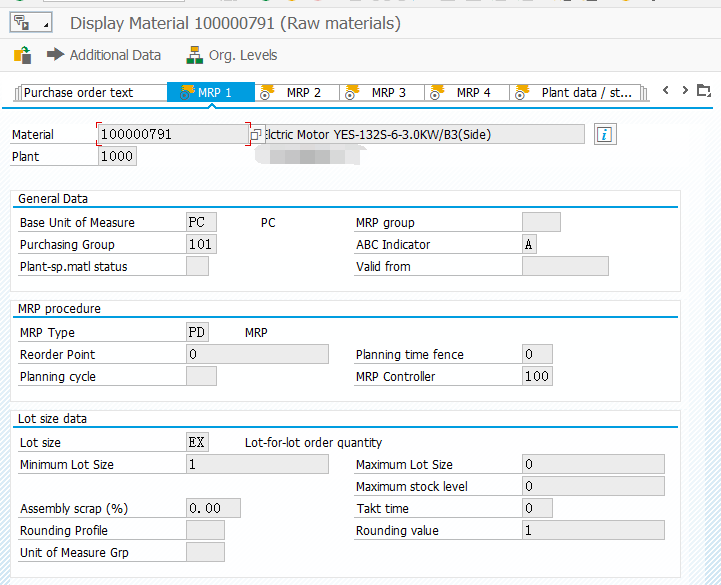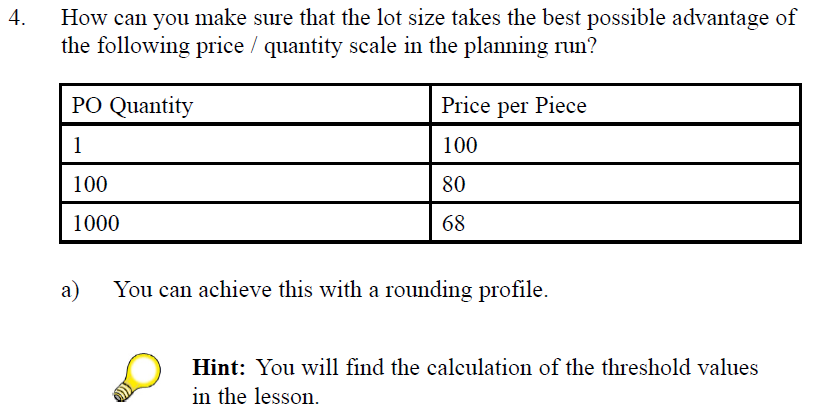1.Lot size calculation
Three groups of procedures exist for calculating the lot size:
- Static lot-sizing procedures
- Period lot-sizing procedures
- Optimizing lot-sizing procedures
The result of the lot-sizing calculation is the amount of a material for production or acquisition.
Define lot-sizing procedures in Customizing for Materials Management under
Consumption-Based Planning → Planning → Lot-Size Calculation → Define Lot-Sizing Procedure.
1.1 Static lot size calculation
- lot-for-lot order quanlity
- fixed order quanlity
- replenish to maxmium stock level
In the static lot size procedure,the procument quantity is calculated using only the enterted quantities in the material master data.
2.Rounding Profile

2. Miantain Rounding Profile
Path:IMG-->Materials management-->Consumption-based planning-->Planning-->Lot-size Calculation-->Maintain Rounding Profile

You can define the rounding profiles in conjunction with a plant,also can leave it empty.For the purpose of this exercise,you should leave the plant field empty.Choose Static:

Save.

Some concept questions:
1. What options are there in the SAP system for executing a planning run?
Answer:
Single-item planning (single-level or multi-level)
Total planning online
Total planning in background processing
2. Name the individual subprocesses of a planning run.
Answer:
1. Check the planning file
2. Net requirements calculation
3. Lot-size calculation
4. Scheduling
5. Type of procurement proposals
With the corresponding settings, the system determines a source of supply
during a planning run for externally procured materials, and assigns them
directly to the procurement proposal.
3. The low-level code is the lowest level in which a material appears in all
BOMs.
Answer: True
The low-level code is the lowest level in which a material appears within
all BOMs. The code determines the sequence in which the materials are
planned: First, the system plans all materials with level 0, then all with
level 1, and so on. The lower the low-level code is, the higher the number
assigned to the level.
4. Name the possible planning process types in a total planning run.
Answer: The following planning process types are available in total
planning:
NEUPL for regenerative planning
NETCH for net change planning in the total horizon
NETPL for net change planning only within the planning horizon.
2009 © 2009 SAP AG. All rights reserved. 125
Test Your Knowledge SCM525
5. The plant parameters have higher priority than the MRP groups.
Answer: False
If a setting is possible on several levels, the setting in the MRP group that is
assigned to the material has priority over the setting in the plant parameters.
In total planning, the system checks for each material whether the material
was allocated a MRP group. If no MRP group is allocated for the material,
the material is planned using plant parameters. If a MRP group is allocated
to the material, the material is planned using MRP group parameters.
6. In which screen areas can you break down a MRP list?
Answer: A, C, D
Each MRP list is divided into a header section and an item section. In the
MRP list header, material data is recorded, for example, the material number,
the plant, and MRP parameters. The item section contains information on the
individual MRP elements (purchase requisitions, planned orders, purchase
orders, and so on). In the left-hand tree in the MRP list, there is a material
tree that you can choose to either show or hide.
7. What are the options for converting a planned order into a purchase
requisition?
Answer:
Individual conversion
Collective conversion
There is a difference between collective conversion online and collective
conversion in background processing.
126 © 2009 SAP AG. All rights reserved. 2009
SCM525 Test Your Knowledge
8. Changes made after the planning date are not considered in the MRP list.
Answer: True
The system creates MRP lists during the planning run depending on the
creation indicator MRP lists. These lists contain the planning results for the
material. The MRP list always displays the stock/requirements situation at
the time of the last planning run, and provides a work basis for the MRP
controller. Any changes made after the planning date are not considered.
The list is static.
In the current stock/requirements list, the most up-to-date development of
stocks and requirements displays. The main difference between the MRP list
and the stock/requirements list is that each time the stock/requirements list is
called, the system re-reads the various MRP elements and displays the most
up-to-date situation. As a result, you always see the most recent availability
situation for the material in the stock/requirements list. Changes made after
the planning date are displayed directly. The list is dynamic.
9. What settings can you define in Customizing for Consumption-Based
Planning for the exception messages?
Answer: Define the following settings in Customizing for
Consumption-Based Planning for the exception messages:
Whether an exception message should be created
The priority of the exception messages, if several exception messages
were created during the planning run for an MRP element
Which exception messages are to be grouped together into an exception
group
Which exception messages lead to the creation of a MRP list if you
set the creation indicator Create MRP list depending on exception
messages
The exception message text can be changed
10. Which of the following procedures belong to the static lot-sizing procedure?
Answer: A, D, E
The following belong to the static lot-sizing procedure:
Lot-for-lot order quantity
Fixed lot size
Replenish to maximum stock level.
11. Aside from the lot-sizing procedure, name other ways of influencing a lot
size in the material master record.
Answer: Other lot size data in the material master record that influences
the procurement quantity includes:
Rounding value
Rounding profile
Minimum lot size
Maximum lot size
12. Describe the function of a rounding value.
Answer: If you specify a rounding value in the material master record, this
means that the procurement quantity includes the multiple of a purchase
order unit during lot-size calculation. This may be useful if rounding up to
the next pallet size, as pallets are only delivered if they are complete.